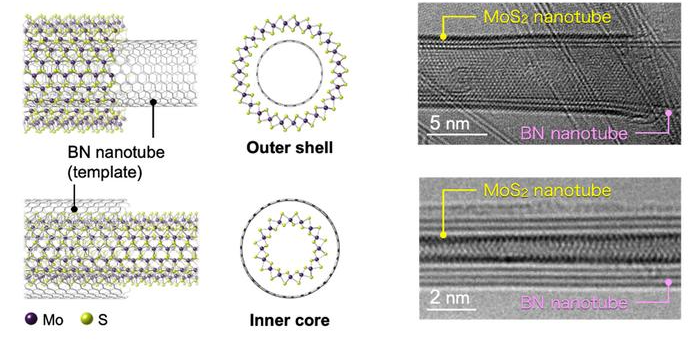By utilizing boron-nitride nanotubes as templates, researchers at Tokyo Metropolitan University have successfully engineered a diverse array of single-walled transition metal dichalcogenide (TMD) nanotubes, each varying in composition, chirality, and diameter. This remarkable breakthrough promises to revolutionize applications in nanotechnology, offering a deeper understanding of the growth mechanisms and emerging optical properties of these nanotubes.
 Boron-nitride nanotubes can template the growth of TMD nanotubes both inside and outside the tube. These can be directly observed by transmission electron microscopy (right). Image Credit: Tokyo Metropolitan University
Boron-nitride nanotubes can template the growth of TMD nanotubes both inside and outside the tube. These can be directly observed by transmission electron microscopy (right). Image Credit: Tokyo Metropolitan University
Carbon nanotubes exhibit outstanding mechanical strength and electrical conductivity, among other peculiar optoelectronic features, and have potential uses in semiconductors beyond the silicon age. Carbon nanotubes are made by rolling up an atomically thin sheet of carbon atoms.
The uniqueness of carbon nanotubes lies in their subtle structural intricacies, such as chirality, a property akin to a "handedness" in their configuration. This chirality, akin to rolling a piece of paper at an angle, imparts distinctive properties to nanotubes, setting them apart from their mirror-image counterparts. However, researchers are now exploring materials beyond carbon that could enable a broader spectrum of structural possibilities.
One of the spotlighted alternatives is transition metal dichalcogenides (TMD) compounds, composed of transition metals and Group 16 elements. These materials offer attributes not observed in carbon nanotubes, including superconductivity and photovoltaic properties, where exposure to light generates voltage or current.
To harness the full potential of TMDs, scientists must synthesize single-walled nanotubes with varying compositions, diameters, and chirality to study their individual characteristics. However, this task has proven challenging, as TMD nanotubes often form in multi-walled structures with differing chiralities in each layer, complicating the identification of specific attributes linked to chirality.
Assistant Professor Yusuke Nakanishi's team from Tokyo Metropolitan University has now devised a solution to this challenge. By introducing the necessary elements through vapor exposure to boron-nitride nanotubes as templates, they have successfully created a spectrum of single-walled TMD nanotubes. Their meticulous analysis of individual nanotubes has unveiled a range of tubes with distinct diameters and chirality.
This breakthrough was achieved by measuring the "chiral angles" of individual nanotubes, which, in conjunction with their diameters, determine unique chiral configurations. Notably, the researchers discovered that the chiral angles of their nanotubes were randomly distributed for the first time. This signifies that they now have access to the entire spectrum of possible angles, offering fresh insights into the intricate relationship between chirality and electronic states—a pivotal, unsolved question in the field.
Furthermore, the team has managed to alter both the metal and the chalcogen, successfully producing molybdenum selenide, tungsten selenide, and molybdenum tungsten sulfide alloy nanotubes. They have also achieved a remarkable feat by creating "Janus"-type nanotubes, named after the two-faced deity of Roman mythology, with one element on the exterior and another on the interior.
With these diverse developments in the nanotube family, researchers are poised to gain a deeper understanding of TMD nanotubes and how their unique properties emerge from their intricate structures.
This pioneering research received support from JSPS KAKENHI Grants (Grant Numbers JP23H01807, JP20H02572, JP21H05232, JP21H05234, JP22K04886, JP22H05468, JP22H01911, JP22H02573, JP21H05017, JP22H05469, JP23H00259, JP23K13635, JP23H00097, JP22H05441, JP21H05235, JPJSJRP20221202), the JST CREST Program (Grant Numbers JPMJCR17I5 and JPMJCR20B1), and the JST FOREST Program (Grant Number JPMJFR213X).
Journal Reference:
Nakanishi, Y., et al. (2023) Structural Diversity of Single-Walled Transition Metal Dichalcogenide Nanotubes Grown via Template Reaction. Advanced Materials. doi:10.1002/adma.202306631